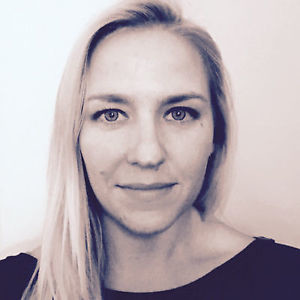On October 15-18, Service Design Week presented three days of dynamic, engaging speakers, workshops, and activities in Boston.
As co-chair of the Financial Services Focus Day, I had the privilege to introduce a series of leaders who have created and sustained meaningful, human-centered change in their organizations. Topics included the rising importance of service design to the financial services industry, how to overcome barriers to innovation, and designing for financial services in 2020 and beyond.
I recently connected with several speakers to learn more about their backgrounds, how they’ve integrated service design into their organizations, and what they see as critical for the future success of financial services.
In this first interview, I spoke with Elizabeth Trudeau, Founder and Head of Strategic Design at Wells Fargo. Liz was our first speaker on the topic “How Can a Strategic Design Function Impact a Financial Services Organization?”
Tell us a little bit about your background?

Elizabeth Trudeau
I lead an enterprise team called Strategic Design at Wells Fargo. We
work as an internal professional services organization and take on
complex problems for different businesses across the company. Our
approach brings together business perspective and human-centered design.
How do you explain design thinking and service design inside your organization?

Elizabeth Trudeau
I don’t talk much about design thinking or service design beyond our
team. I talk about solving problems or going after opportunities because
that’s what people care about. Beyond design teams, I tend to focus on
just a few aspects – curiosity, experimentation, empathy and
discourse-driven collaboration. I should note that I didn’t bring design
thinking and service design to the company. Customer-facing design and
research teams have been at this for a while. However, it’s often
downstream from where many strategic decisions and priorities are set.
By the time that something gets to implementation, the amount of wiggle
room you had was very small. The opportunity I saw was: if we could
bring those skills and thinking to earlier-stage work, we could have a
greater impact on what ends up hitting the customer or team member. We
could also start to change the business practices and mindsets - about
the way that we work and the type of company we want to be. My
hypothesis was that we would get better outcomes and become a more
engaging place to work. When I founded this team, it was a team of one
(me). Then we started to add one person at a time. Now we're a team of
10, and we still continue to grow as a result of the impact we are
making.
To get started, I didn’t lead with design or design thinking. The case I
made to the organization was there is a need for us to have better
innovation and problem solving capabilities. Why? Because the world is
changing so quickly and we are not prepared to deal with the level of
complexity. So we have two choices. We can either over simplify complex
challenges and therefore create overly simplified and ineffective
solutions, or we can amp up our innovation and problem-solving
capabilities. I then positioned the team as the solution for businesses
looking to accelerate progress and reimagine possibilities around hairy
challenges.

Shaun Gummere
You described that beautifully. Simple approaches yield simple solutions
versus it's complicated. You have to embrace complexity. Is that a fair
reflection?

Elizabeth Trudeau
Yes, a fair reflection. We first have to get to the effective outcome.
And then we can simplify it.
You’re an innovation design thinking leader but how does service design fit
into that world?

Elizabeth Trudeau
Our work connects to the more formal definition of service design.
Generally speaking, service design is the combination of upfront
innovation, fuzzy front end strategy, physical experience design,
digital experience design, and process design. All of those things have
to work together. Most of our capabilities are in the fuzzy front end
and that leads into experience design. The people on the team are great
researchers, full-brain thinkers, and most importantly can handle an
immense amount of ambiguity. When you’re working across the entire
company, there's ambiguity at every layer of the problem.

Shaun Gummere
We call this contingent thinking - being able to hold a lot of
possibilities at once and then precipitate out of direction to test.

Elizabeth Trudeau
I like that. Our model has been: bring us your biggest problem and we
will help you solve it.
As you look out over the next couple of years, what are the biggest
challenges to overcome?

Elizabeth Trudeau
There's a lot of unknowns and large organizations are having to depart
way from how they have historically done business in the past. In its
simplest form, an organization is just a collection of people and norms.
Shifting the way people behave and think is incredibly difficult. One of
the biggest challenges is getting people to behave differently at scale
and change the way the company thinks. But there are other challenges
like having to contend with legacy systems, competing priorities, and
the value tension between multiple stakeholders that a large company
serves.

Shaun Gummere
It's a big culture shift in a way. Would you use that term?

Elizabeth Trudeau
I would say it is. It's a big culture shift, but I think it comes down
to whether or not somebody is willing to swim upstream and try doing
something different.
We run into some of the same implementation challenges that professional
services companies face when working with large organizations. It's
great to come in and do a project but the minute the project is over,
people want to go back to the way things were. That’s why so much
consulting work ends up sitting on the shelf.
Bridging the gap between the good idea and getting it to stick is critical.
Do you have any key advice for making that happen?

Elizabeth Trudeau
We try to build it into the way that we pick projects. My team spends a
lot of time figuring out how do we design for feasibility or design for
implementation. Therefore, throughout our engagement, we’re constantly
asking ourselves: how does this organization work? how do they make
decisions? who has the power? what is their worldview? And what do they
need to believe? The only way I've seen change happen is when people see
they can do it themselves. The goal with every project is to have a
story that can inspire change.
You mentioned wanting to change the way the company thinks. If you could
wave a magic wand and arrive in the promised land, what would that look like?

Elizabeth Trudeau
Broadly speaking, the first thing I would notice: Is there a level of
openness and vulnerability in the way we talk about the work? I think
that's critical. One of my favorite authors is Brene Brown. I think
she's spot on regarding the level of courage and vulnerability that it
takes to lead change. We have to be change organizations, not just an
organization that’s going through a change initiative.
We need people that promote change around us constantly. That's the only
way we can thrive in the future. And I think that takes a remarkable
amount of candor and vulnerability.
The other thing I would see: are people perpetually testing their
assumptions or are they getting caught in the perfection trap early on?
How many iterations are we doing? How many ideas are being killed? Those
would be a great measure of progress. It sounds depressing, but I think
it's so much more depressing to spend time on things that aren't worth
it.

Shaun Gummere
You made me think of one of the nicer compliments I got many years ago.
He said, "Shaun, you're one of the people who say, “I don't know” in a
way that makes it sound like it's not a bad thing, but a really good
thing." I think the vulnerability you're describing resonates for me so
much.
innovation?

Elizabeth Trudeau
Beyond the usual lists that you can pull from anywhere, I've really
enjoyed Learn or Die by Ed Hess. It's about becoming a learning
organization. Daring Greatly by Brene Brown is also great. I also
like anything and everything related to behavioral economics. A good but
heavy example is Thinking, Fast and Slow by Daniel Kahneman.
There are also great how-to and reference books like
Mapping Experiences by Jim Kalbach. Jobs-to-be-done—I feel like
we haven’t done enough with that.
What didn’t I ask you that I should have?

Elizabeth Trudeau
How do you keep a team of 10 doing this work in a huge company? How do
you build and maintain a healthy team?

Shaun Gummere
That's a great question especially in a big organization where you're
swimming upstream in a lot of ways. What advice do you have there?

Elizabeth Trudeau
What's worked for me is having a vision and getting people excited about
it. That is the only reason people have joined this team – and I have an
amazing team. And the only reason that people stay on the team is
creating an environment that really embodies what you hope to see in the
organization. We’re not waiting to have it happen—we’re going to be that
team. You have to go out on a limb for the team and be willing to push
boundaries.

Shaun Gummere
That's terrific. Recently, we rearticulated our design principles and
one of the ones we included was "Be Brave," because people pay us to
tell them the truth. It’s often hard enough to bring a consultant in,
and then they tell you what you already know or what they think you want
to hear — you have to be really brave. That goes along with everything
you’ve been saying, it’s like the two sides of a coin. On the end
there's vulnerability, on the other end there's bravery. And then
there's positivity of culture and purpose. It all comes together.

Elizabeth Trudeau
That’s spot on. It is that bravery - that double-sided coin where you
have to simultaneously empathize with clients and then also push back on
them, and tell them when you think they're wrong. I had a team member
tell me yesterday that one of his most memorable professional moments
was when I stood my ground for the team during a meeting with a client.
I had no idea that act would be so meaningful to my team but,
apparently, it was incredibly meaningful to them.

Shaun Gummere
Thank you for chatting with me today and I look forward to hearing you
speak at Service Design Week in October.
If you are interested in learning more about our Experience Strategy and Service Design practice, please reach out to us at hello@cantina.co or use our contact us form.





